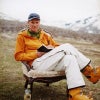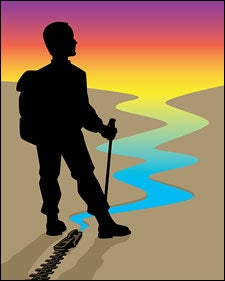Ten years back, when the first ���ϳԹ��� Buyer’s Guide hit newsstands, a soft shell was a menu item at Red Lobster, a GPS receiver was about the size of a shoe box, and, if our earnest product tutorials were any indication, in-line skates required nothing short of an engineering degree to master. “Wheel hardness is rated by a durometer number,” we wrote back in 1995.
Get the Goods!
ON NEWSSTANDS NOW: The 2005 ���ϳԹ��� Buyer’s Guide, stuffed with 420-plus hot products tweaked, trampled, and tested by the experts. Buy it now and find everything you need for TRAVEL, ADVENTURE, SPORTS, and FITNESS, including Gear of the Year, Killer Values, and Gear to Covet.gear of the year
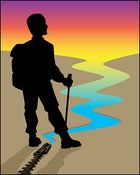
Ouch.
History is indeed a brutal judge, and, perused today, the inaugural edition of this magazine would offer the sophisticated gearhead page after page of hindsight-powered giggle fits. But it also underscores a greater truth: ���ϳԹ��� equipment and apparel are as much reflections of the day as music, food, fashion, television, or any other slice of the grand Google database that is contemporary American consumer culture.
We can already hear the purists slumping in their external-frame packs. “There’s nothing trendy about gear, and that’s the way it oughta be,” these old-schoolers will argue. “Never mind what color it is,” they’ll huff; “does it have a polytetrafluoroethylene membrane and a tear strength of at least 60 pounds? Does the hipbelt offer adequate padding over the iliac crest?”
True, these things are important, but good design does more than just solve engineering problems: It generates an emotional response. It harmonizes with that ineffable thing called style and the complex connections of trend. And though there have been significant improvements in, say, the available colors and cuts of backcountry-ready apparel—well, for women, that is—we still have work to do. Walk into any specialty gear shop and take a look at the inevitable wall o’ shoes. Bet you an ���ϳԹ��� subscription that it’s a stylistic dirge in the keys of moss, slate, and mud.
To be fair, almost every classic outdoor brand—from Cloudveil to The North Face to Marmot—is tinkering with street-smart pieces, and some are rather sweet. The technical DNA is still very much present in these shirts and pants, but you can also wear them around town without looking like you just trekked down from advance base camp. Other innovators are finding ways to reach new buyers—66°rth, a gorgeous technical-apparel line from Iceland, is flying off the racks over at Urban Outfitters. Victorinox is at Bloomingdale’s. Meanwhile, Jeffrey Wolfe, cofounder of the Detroit-based gear chain Moosejaw, is using the Web to reach urbanites who might be too intimidated to venture into that shop with the big-wall-climbing diorama in the window.
The truth is, our world has changed. We’re opening up the lens on a brand-new golden age of cool, one that flips easily between backcountry and front. Today’s shoppers—and, yes, we’re talking about hardcore guys—are unapologetically style-savvy. They know what not to wear. And they’re in the market for hip performance clothing that can carry them from the trail to the office, out on a weekend getaway, or just down to the local java spot for a Saturday-morning dog summit.
Which brings us to this new, expanded, reinvigorated—dare we say, somewhat sexed-up—2005 ���ϳԹ��� Buyer’s Guide. You won’t find any waffled long underwear here. Nor will you find a lot of royal blue. Instead, for every corner of this guide, we’ve sought out brands and products that work as hard as you do, pieces that have durability completely nailed but also look sharp while performing. When you’re outfitted to look good, you feel good. Job done.
Recognizing that not every moment of your active life is spent on belay (though maybe you wish it were), we’ve introduced a lifestyle section. There you’ll find a wicked espresso machine and a new scooter, plus digital music players, laptops, PDAs, urban attachés, sporty sunglasses that don’t scream “outdoor geek,” and those quintessential pieces of beach-poaching gear, the flip-flop and sandal.
Not that we’ve gone soft on you. You’ll still find our top picks for the best expedition equipment ever—each candidate was subjected to our trademark regimen of torture trials. Tents were set up in the dark in driving rain high in the Cascades; digital cameras were grip-tested on vertical granite faces in British Columbia; luggage was thrown from the roof of a bus in Panama; and at least one bag was peed on by primates in Nevis (yes, really).
As in past years, we’ve bestowed our coveted , from sleeping bags to binoculars to kayaks. When it comes to the equipment and apparel you’ll trust with your life, we take our jobs very seriously indeed.
Question from the back row—the gentleman in the glacier glasses? Yes, you’ve got a point: Today’s ice-blue soft shell will look about as au courant ten years from now as the neon-pink jogging tights in our first issue do today. But you want to look good out there now, right? Then that’s the price you pay, brother.
Gear of the Year
Road Bikes & Mountain Bikes
Giant TCR Composite 2 $2,100
You could pay more than twice as much for a bike and not have this much fun. With a one-piece carbon frame, competition-worthy components, and intuitive handling, this Gear of the Year winner is an entry-level racer that moves “entry level” into the same neighborhood as “elite.”
1. For all its strengths on the hills, the Giant TCR really sparkles on the flats. Settle into a steady groove and you’ll sense that every fiber—in both the hyperefficient carbon frame and your muscles—is working to propel you forward.
2. Descending steep switchbacks or rounding city corners at speed, the TCR dives in and holds its line without any of the nervous twitchiness that can make some race rigs unsettling.
3. Giant has always offered great parts for the money, and the TCR doesn’t disappoint. Five years ago, a frame of this quality could have cost close to $5,000. To get it hung top to bottom with Shimano’s precision Ultegra drivetrain for just over two grand is unreal.
4. The TCR is available in five sizes, with Giant’s compact road geometry allowing for enough seat-and-handlebar-stem combinations to keep pretty much anyone comfortable and properly posi-tioned for the big ride.
5. The compact frame design and one-piece construction keep this 17-pound-seven- ounce rocket light and rigid—no extra tubing or complex joints to add weight or flex. You’ll climb faster. Period.
GT i-DXC 1.0 $2,600
GT designed its new i-DXC around the latest version of the company’s superefficient i-Drive suspension setup, so it rides as comfortably as a cross-country bike—without sacrificing race-day speed. Whatever your singletrack agenda, this Gear of the Year winner is equally equipped to play in the backcountry or jump into the competitive fray.
1. GT’s ingenious i-Drive isolates the drivetrain from the suspension to keep the distance between the cranks and the rear wheel constant. This eliminates the annoying chain “kick” that plagues many suspension setups.
2. The aluminum frame provides a rigid and necessary counterbalance to the cushy suspension. The rear triangle holds up under aggressive turns and hard, side-to-side cranking.
3. Wildly popular Crank Brothers Eggbeater pedals top off a great components mix—including a Shimano XT drivetrain that’s precise enough for racing yet burly enough to spare you a lot of expensive visits to your mechanic.
4. Four inches of travel adjust on a dime with Fox’s 3.5-pound F100R fork. Laterally stiff and sensitive as you want it to be, the front suspension improves handling in all situations.
5. Fox’s new Float RP3 rear shock really shines. By flipping a small lever, you can adjust pedaling efficiency as conditions dictate—more for climbs, less for drops—without losing any big-hit reserves.
Gear of the Year
Digital Cameras & Digital-Audio Players
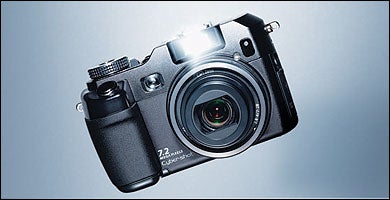
Apple iPod Photo
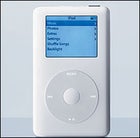 Apple iPod Photo
Apple iPod PhotoSony Cyber-shot DSC-V3 Pro $600
Sony’s 7.2-megapixel DSC-V3 nabs Gear of the Year by combining the soul of a pro-level SLR with silicon guts capable of punching out truly tack-sharp images. Thanks to a blindingly fast processor, you won’t have to forfeit now-or-never moments to “shutter lag”—that maddening pause between hitting the button and nailing the snap.
1. Thanks to its Real Imaging Processor—one of the speediest in the biz—the V3 will fire off eight pics at a respectable two frames per second before coming up for air. And that’s at full resolution.
2. Some of the best photo ops occur after dark, but it’s tough to set up a shot you can’t see. At least, it used to be. Select the V3’s infrared mode and frame up your otherwise blacked-out subject via a surveillance-cam-style black-and-white view.
3. The V3’s magnesium-alloy-and-plastic body flies in the face of the market’s tiny-is-best obsession. A good thing? You bet. While the V3 still fit inside my pack lid, its rubberized right-hand grip was easy to hold on to—even with sweaty digits—during a white-knuckle Latin America bus ride.
4. Almost all digicams—and let’s not forget some cell phones—can shoot movies, but few offer the V3’s TV-screen quality and 30-frames-per-second clarity. And with its anti-reflective 2.5-inch LCD preview screen, reliving your directorial debut is easy, even in bright sun.
5. You won’t find a competitively priced digital camera that can capture movement with such rapid autofocus and shutter response. Even with the zoom fully maxed out, I snapped a perfectly focused shot of a mountain biker coming in hot around a bend at dusk.
Apple iPod Photo $499
The killer app of the digital music revolution leapfrogs the pack by inviting your camera to the party. This 40-gig Gear of the Year champ easily organizes and pumps out 10,000 songs—or up to 25,000 photos, which you can spin through about as quickly as you can shuffle a deck of cards.
1. The lightning-fast 220-by-176-pixel LCD display renders your digital photos in 65,536 brilliant colors. View splashy album-cover art when playing a tune or set some shots to music before plugging into your plasma TV for a very 2005 slide show.
2. Apple’s iTunes Music Store—accessed via free OS X and Windows software—offers an impressive music catalog. Albums typically run $10, while single tracks go for 99 cents a click. Jam out to iTunes exclusives from the likes of U2, plus celebrity playlists.
3. No other player offers so many cool accessories. To wit: A media reader will transfer photos directly from your digital camera’s memory card to your iPod, FM transmitters will pipe your tunes through your car stereo, and a voice recorder will archive memos, interviews, and lectures.
4. Store contacts, reminders, and text files on the iPod’s calendar and scheduler, compatible with Microsoft Outlook and Apple’s iCal. An alarm gets you to your meeting on time, and a sleep timer lets you doze off to the Shins without sucking your battery dry.
5. Stuck in Layover Land? Apple stocks its iPods with diversions aplenty. Play solitaire, Parachute, Brick, and other vintage video games. Then test your knowledge of your own music library via Music Quiz, Apple’s equivalent of Name That Tune.
Gear of the Year
Camping Tents & Sleeping Bags
Sierra Designs Reverse Combi $240
At six pounds 13 ounces, the Reverse Combi is the heaviest of the eight new-for-2005 shelters we tested—and is probably the most tent you’ll want to carry. But this Gear of the Year’s thoughtful design and creature comforts threw our usual light-is-right rules out the mesh window. Perhaps bigger is better.
1. When you’re not obsessing over pounds, you can draw from a more appetizing menu of features: The Reverse Combi’s color-coded webbing speeds setup; pole tips lock into grommets for stability; and doors tuck nicely into side pockets to stay clean and out of the way.
2. If the Combi feels roomier than its 4.5-by-seven-foot floor plan suggests, it’s not the single-malt talking. Sierra Designs cleverly located varying diameter pole sections to create steeper walls and more living space than other similarly configured tents.
3. While many of today’s tents are cut prosciutto-thin to shave ounces, this shelter’s floor, body, and fly are made of heavier-gauge 70-denier nylon or taffeta nylon. With a new antimicrobial finish—designed to head off potential stuffsack funk—the Combi conveys a reassuring air of solidity; I expect it will still be inviting abuse in 2015.
4. Many side-entry tents have just one door, and heeding nature’s call can also mean waking up your camping chum. Luckily, the Combi gives each occupant an escape route. Another twofer: dueling 11-square-foot vestibules, each with a door that rolls up and out of the way.
5. With the rain fly staked out taut, the dome hunkered down like a tortoise, scarcely shuddering during a night of meteorological Sturm und Drang below Washington’s Mount Stuart. One quibble: The vestibules have pretty small windows.
Marmot Atom $229
Behold the Gear of the Year: A 16-ounce, 900-fill-down wonder that’s destined to be the new sleep standard for fastpackers and anyone else who appreciates gossamer weight in a three-season bag. Marmot’s ultrastuffable Atom practically vanishes into your pack.
1. How feathery is the Atom, with its Ÿber-premium down and superlight Pertex fabric? It reminded me of a chunk of San Francisco fog I once spotted scudding along California Street. How compressible? Picture a cantaloupe.
2. The Atom’s trapezoidal footbox—the bag’s bottom end swoops upward like a ski tip—won’t force you to splay your feet sideways.
3. Its 40-degree threshold might seem sketchy, but this nocturnal nest is all you need for most late-spring-through-early-autumn outings: It kept me—as well as several eager-to-try-it friends—toasty on a chilly September summit attempt yet stayed cool on summer car-camping trips to my local crags.
4. With its half-zip, the Atom won’t be mistaken for a stateroom, but it slips on like silk pajamas and is roomy enough around the shoulders for sleepers who don’t toss like a Maytag all night long.
5. Not many above-freezing bags sport a mummy hood, complete with an insulated face muff, and a cinch cord to batten down the hatches on brisk nights. Outfit yourself with a wool cap and some merino long underwear and push the Atom’s rating down to the frost line.
Gear of the Year
Road Runners & Trail Runners
Nike Free 5.0 $85
For decades, world-class athletes have conditioned their feet—and upped the speed at which they shift from one foot to the next—by leaving their shoes at home. Nike gets barefoot-running religion with the Free, which distills the training shoe to its very essence. For an ultra-minimalist platform, this year’s Gear of the Year winner is an astonishing performer.
1. Try out the Nike Free sans socks. Even sockless, there’s no chafe: Soft synthetic suede covers a seamless elastic-mesh upper. On both longish runs and quick neighborhood trots my feet felt solidly encased—yet were free to move where they pleased.
2. Most running shoes are designed to flex underfoot in front of the laces. The Free, scored on the underside like a chocolate bar, can be squished down to the size of a mango, and the shoe moves and bends every direction your foot would naturally.
3. Forget rock-solid heel plates locking your dogs in place. The Free instead offers a millimeter of elastic mesh. Thus liberated, my feet found a neutral, ultra-comfortable zone—instead of one dictated by multiple layers of material.
4. Acknowledging that every foot has its own idiosyncrasies, Nike sells the Free with two sculpted inserts. Start with the thicker one and, as you strengthen the muscles in your feet, move on to its thinner counterpart.
5. The midsole and arch support are much thinner and softer than those in conventional shoes, but there’s still enough lift and protection to guarantee some stability without compromising freedom of movement.
Montrail Hardrock Wide $93
When we finally terraform Mars, the first colonists will doubtless be issued Montrail Hardrock Wides—kicks perfectly suited to the dusty slopes of 78,740-foot-high Olympus Mons. OK, admittedly, we’re reaching, but our 2005 Gear of the Year trail runners have more than proved their worth on this planet, moving effortlessly from scree to sandstone to the blacktop that took us there.
1. The Hardrock Wide’s firm and deeply sculpted heel cup fits as if it’s been bone-grafted onto your foot. Superstellar. It’s impossible to fumble your stride with your heel so locked in place.
2. Size-EE feet feel at home in the Wides yet never go unsupported—thanks to a full-length polyurethane plate that wraps up, taco style, around the midfoot for torsional control. (There’s a standard width available for skinnier feet.) Overpronation is regulated with the authority of a strict school nun.
3. Montrail embraces chaos theory on the outsole—it’s bristling with triangles, bars, and dots—and the result is traction uphill, downhill, and sideways in dirt. On rock, the rubber lugs are shallow and stiff enough to grip tightly.
4. A midsole of dual-density EVA and a gel insert in the forefoot lend perfect plumpness—enough for forays on asphalt (not always the case with trail shoes) without the foot/trail disconnect that gives you that whoa! feeling on steep switchbacks.
5. Nylon mesh in the uppers ensures good ventilation, and copious synthetic leather embellished with raised rubber bumpers fends off rock scrapes and debris collisions.
Gear of the Year
Storm Shells & Soft Shells
REI Taku $199
Remember that high school buddy who souped up an old Datsun 510, then went looking for suckers to race? The Taku is his kind of jacket. At first glance this 2005 Gear of the Year pick is just another storm shell, but a closer look reveals a whole lotta functional horsepower.
1. The co-op deploys both “hard” and “soft” fabrics in all the right places, tapes all seams, and pulls off impressive abrasion resistance throughout. Swaths of Elements—REI’s three-layer waterproof-breathable fabric—shed Cascades-grade deluges on hood, shoulders, and cuffs.
2. An inside zipper flap shuts out drafts and keeps this jacket looking sleek, while rubberized pulls make opening and closing effortless, even with chubby gloves.
3. Thanks to stretchy, snug-fitting side panels, the Taku’s hood cinches around both your head and face for a fit that feels custom-molded. Even in the whipping wind at Point Reyes National Seashore, the hood stayed put, my peripheral vision remained clear, and I could actually hear what my friend was saying.
4. A single sidepiece, span- ning from waist to wrist, prevents the Taku from riding up when you reach, midcloudburst, to clamp your bike down on the roof rack. Near-invisible core vents, positioned out of the path of pack straps, afford full access to your base-layer pockets.
5. Go ahead, layer it with a deep-pile fleece. The Taku’s well-tailored, articulated design—seven fabric panels per facing side—won’t make you feel like you’re wearing a snowsuit.
Patagonia Ready Mix $199
Sick of the bulk and crinkle of traditional shells? The doctor prescribes the new bargain-priced Patagonia Ready Mix, an airy dream of silky, stretchy protection that packs down to the size of a pomelo. This sensual soft shell is all you need for everything but the soppingest, most high-impact endeavors, which is why it gets Gear of the Year.
1. Cycling in Portland, Oregon, one particularly nasty day, I was amazed by how the supple Ready Mix thwarted a spanking rain. As I madly pedaled my way to an espresso joint, Patagonia’s durable water-resistant Deluge finish kept me dry as biscotti.
2. Spacious chest vents eliminate the need for pit zips—and double as glove compartments, without significantly sacrificing airflow. Plus the Napoleon pocket can easily stash a couple of hoagies.
3. Inside and out, welded seams fuse 3.4-ounce double-weave stretch panels, which are oriented for pitch and yaw to allow maximum freedom of movement. Reinforced shoulder, elbow, and hip panels—constructed of beefier 5.5-ounce poly—protect chafe points. She may be soft, but she’s tough, too.
4. Dig the subtle touches: an offset zip that ends up next to—not under—your chin; a self-cinching hood; a smushy visor that holds its form; Swiss-cheese-like hook-and-loop closures at the cuffs to shave weight; and watertight zips.
5. The smart design of the Ready Mix meshes slinky comfort with serious utility. Like a classic shell, it’s fully featured, but its cocktail of unbeatable breathability, easy one-hand cinching, ultralight heft (only 14 ounces!), and windproof fabric shifts the paradigm.
Gear of the Year
Luggage & Backpacks
Eagle Creek Switchback Max ES 25 $295
Here’s a cleanly designed multitasker with the right goods for road tripping, globe-trotting, or anything in between. Trundle this 2005 Gear of the Year fave up to the reception desk at the W Hotel without looking like you’re fresh off the mountain, then zip off the bomber backpack to launch into the urban jungle—or more challenging environs.
1. Don’t sweat the baggage handlers. The Switchback protects your possessions like a fortress, with a tough skid plate, corner guards, and beefy ripstop-nylon construction. Because the design gurus deploy heavier fabric only at abrasion hot spots, the whole package stays relatively light: 11 pounds.
2. As far as wheelies go, this 4,300-cube hybrid hauler drives like a dream, thanks to an ergonomically curved locking handle that shifts your load onto the rollers. A side-haul grip and padded top handle offer good grab when the time comes to muscle the Switchback up into the TGV vestibule.
3. Forget futzing with extraneous organizational doodads in the main compartment. Zip open the top panel to reveal a spacious interior rigged with an adjustable mesh-buckle system that compresses and secures take-alongs, plus a zippered laundry pocket.
4. The detachable daypack ain’t no afterthought—at 1,500 cubic inches, it’s plenty big for urban or rugged forays. (It easily garaged my laptop for morning caffeine recon missions.) Dual stow-away water-bottle holders inject trekking DNA, and the front zippered pocket sports sleeves for gizmos and paperwork.
5. In bipedal mode, the zip-out backpack suspension and 3-D lumbar material are downright plush, especially where it matters most—over your tailbone. Sculpted shoulder, sternum, and load-lifter straps are all fully adjustable—and ready for any multi-day trek.
Osprey Atmos 50 $199
At first glance, this hauler might seem born out of Lockheed’s Skunkworks, but relax: Our Gear of the Year pack will get you there and back in a flash. A matchless mesh suspension setup saves aches and ounces, while the main compartment smartly stows as much or as little as you like. You’ll be sure to uncover something new every time you take the Osprey out.
1. Like a stretchy cotton hammock, the breezy back panel keeps you happily cool while it supports up to 3,000 cubic inches of swag. Hinged aluminum stays direct weight to the hipbelt, and the shoulder straps comfortably bear the balance.
2. A sleeping bag, clothes, food, and other sundry items slide easily into the main compartment, while accessible twin side pockets hold Nalgenes, fuel, or even a flask filled with whiskey—you devil, you! On the outside, diagonal compression straps tote trekking poles and the kitchen sink.
3. Shoulder straps and hipbelt are perforated to save weight without skimping on comfort.
4. Helpful extras make a good pack better: A supple shovel pocket can stash just-in-case raingear; there’s a bonus cubby behind the mesh back panel for an extra hydration pack (or a smelly shirt); and bottom compression straps batten down a sleeping pad nicely.
5. Don’t be the fiddler. Light and fast means well-placed straps and seams that steer clear of pocket zippers, grant-ing hassle-free access to your must-have stuff. On a sun-drenched trail, I easily shed and stored layers—without adding frustration.
Gear of the Year
Light Hikers & Kayaks
Garmont Eclipse XCR $120
Stripped-down light hikers can leave weekend adventurers craving a little more of everything. But, just like my pre-ramble, all-you-can-eat Southern breakfast, the Eclipse XCR fills the plate. Balancing strength and flexibility, this waterproof Gear of the Year winner made a meal of Alabama’s rugged Pinhoti Trail in a hard winter rain.
1. Ankle sprains are the Achilles’ heel of low-cut footwear, but the Eclipse XCR fights back. A high inner cuff stabilizes the joint to discourage it from rolling inward, while a rigid leather strip lining the outside of the upper cuff kept me secure on the scree.
2. Many load-bearing hikers have overbuilt heels that impart a ski-boot gait—not pretty when you’re negotiating a crowded pub with a full, après-tramp pint. However, the back of the heel on the Eclipse swoops upward, for sneaker-like strolling.
3. Smallish tongues can shift, often leading to chafing at the intersection of ankle and foot. To reduce slippage, Garmont equipped this hiker with a broader tongue that extends down toward the ankle on the inboard side of your foot.
4. Even after shouldering a 30-pound pack, the plastic web in the cushy midsole kept my feet in the game. I could feel the material working like an in-shoe backbone, supporting my soles and lessening fatigue without compromising flex.
5. You won’t slosh around in these bad lads, thanks to a Gore-Tex XCR membrane, which functions like a pair of rubber galoshes. But watch out: XCR can choke in high temps; my toes felt damp after trekking through steamy ravines in the soggy Chattahoochee National Forest.
Dagger Crazy 88 $1,150
Ready to go pro? Then you already know that tricks are for kids—and success hinges on huge air. Enter Dagger’s Crazy 88, our Gear of the Year selection. This boat is a masterly equation of length, width, weight, and volume distribution, all of which pull together when the time comes to skip off the lip and into the big time.
1. The upswept cockpit increases the boat’s overall buoyancy; while popping out of front flips and back flips, I felt like I was on a trampoline.
2. Dagger equipped the Crazy 88 with an add-on called an Overthruster. The detachable plastic pod—about the size of an airline meal tray—increases the boat’s volume, ergo its buoyancy. Plunging into the same hole avec and sans Overthruster proved its worth: an extra foot or so of vertical.
3. The Crazy 88 was designed for radical maneuvers like aerial backstabs—picture a back-to-front rotation at a 45-degree angle—but Dagger also softened up this boat’s lines. Result: You’ll quickly recover from a botched stunt—and maybe even call it a new move!
4. An inch or two svelter than the rest of the Dagger fleet, and boasting a flatter hull, this 28-pounder—among the lightest of the ten boats I tested—is both spry and damn fast.
5. Simple and lightweight outfitting—the padding that keeps you snug and comfy in the cockpit—dials in a perfect fit with little fuss. A removable wedge raises the seat to deter thigh cramps, and your perch moves fore and aft on a track to accommodate your height.
Gear of the Year
Sunglasses & Binoculars
Rudy Project Maskeryna $125
Rudy Project hits the sweet spot where sportsworthiness becomes fashion and vice versa. This frameless wonder fends off 70-mile-an-hour winds as effectively as ski goggles, but it’ll also turn heads in Santa Barbara. Add dreamy optics and negligible weight and the result is a Gear of the Year award.
1. The whole shebang—lens and tendril earpieces—is a springy unit that holds onto the head delicately yet quite securely. Without being conspicuously sport-shield-like, the Maskeryna gives all the protection any athlete could ever need.
2. The no-frame wraparound uni-lens is undeniably chic—but it’s also trs sportif, at just over half an ounce. You’ll forget you’re wearing it. Plus the Maskeryna slayed the wind when I stood up in a convertible doing 75 on the Ventura Freeway.
3. The best polycarbonate lenses are injection-molded under very high pressure—and Rudy pummels these shades with over five and a half tons of it per square inch. The result? Crystalline clarity and acuity, plus improved scratch resistance.
4. A warm orange-brown tint blocks blue light—a bane of sharp focus—rendering everything suitably crisp and 3-D. But don’t blink; you might miss the perfect view: This tint also helps speed up visual navigation and, by extension, your road- or mountain-biking pace.
5. Silicone-compound schnoz pads anchor the Maskeryna when you’re sweaty and taking hits and dips from the trail and can also be adjusted for fit. Vanity points: These slender, teardrop-shaped grippies don’t leave deep, red nose-dents.
Brunton Epoch Zoom $1,900
A couple years back, Brunton bagged its first Gear of the Year award with the burly, waterproof, scalpel-sharp Epochs. For 2005, greatness gets an upgrade. The new Brunton Epoch Zoom invites you to view the whole horizon, then drill in tight with the touch of a lever. Result? Another trophy for the mantel.
1. The gunmetal-gray synthetic-rubber coating is simultaneously supple and grippy, and helps these big barrels stand apart from the competition you’ll find at the local wildlife refuge.
2. Most zoom binoculars are gimmicks, with the required extra glass and adjustment lever contributing little more than weight. But the Brunton Epochs are a serious high-performance tool; they allow you to optimize magnification—from 8x to 15x—for the task at hand.
3. A burly but light magnesium-alloy frame keeps the weight of these feature-rich magnifiers at a respectable 32 ounces, while also providing a stout chassis to rebuff the knocks and dings of heavy field use. Oops, backed the Land Rover over your Epochs? The company will resupply anywhere in the world at no charge.
4. The view through these binocs is bright and true: no fogging, color aberration, or distortion on the edges, thanks to nitrogen-filled barrels and fully multicoated lenses and prisms.
5. A supersize, center focus wheel hooked to a variable-speed focusing system—offering fine-tuning close in and lightning-quick target acquisition farther out—makes for smooth transitions from that warbler in the willows to the hawk on the horizon.


